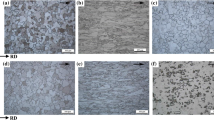Abstract
A 0.085 wt% P micro - alloyed and Ti-stabilized high strength IF (interstitial free) steel was warm rolled under two conditions: One with lubrication and the other without. The results show that lubrication has a significant effect on texture evolution during warm rolling and the subsequent annealing process. Without lubrication, severe shear deformation occurs in the surface layer, which results in recrystallization and the formation of a <110>//ND (normal direction) texture, while the central layer undergoes plane strain deformation and forms a weak <111>//ND deformation texture (typical of bcc iron). With good lubrication, both the surface and central layer experience plane strain deformation and a strong <111>//ND texture is normally formed. The warm rolling texture (which contains both recrystallized and deformed grains) has a profound effect on the subsequent annealing texture. The final textures influence the draw - ability of the plates, i.e. the r - value (r-value: The ratio of the true width strain to the true thickness strain in a sheet tensile test) and |Dr|-value (planar anisotropy coefficient). After annealing, the lubricated plates are characterized by a higher r - value (1.27) and a much lower |Dr|-value (0.075) than those rolled without lubrication (i.e. 0.96 for the r - value and 0.465 for the |Dr|-value).
Similar content being viewed by others
References
C. J. Barrett, Influence of lubrication on through thickness texture of ferritically hot rolled interstitial free steel, Ironmaking and Steelmaking, 26 (5) (1999) 393–397.
A. Azushim, W. D. Xue and Y. Yoshida, Lubrication mechanism in hot rolling by newly developed simulation testing machine, CIRP Annals-Manufacturing Technology, 56 (1) (2007) 297–300.
I. S. Cho, The influence of boundary conditions on the lubrication characteristics of a journal bearing for reciprocating compressors, Journal of Mechanical Science and Technology, 29 (2) (2015) 751–758.
J. G. Lenard, Tribology in metal rolling, CIRP Annals-Manufacturing Technology, 49 (2) (2000) 567–590.
J. H. Park, K. Hamad and I. P. Widiantara, Strain and crystallographic texture evaluation of interstitial free steel cold deformed by differential speed rolling, Materials Letters, 147 (2015) 38–41.
X. Song et al., Texture, grain boundary characterization and segregation of phosphorus in an annealed interstitial free steel, Journal of Iron and Steel Research, International, 21 (9) (2014) 844–848.
X. B. Pan, Effect of technological lubrication on microstructure and texture, Steel Rolling, 29 (4) (2012) 4–7.
A. Haldar and R. K. Ray, Microstructural and textural development in an extra low carbon steel during warm rolling, Materials Science and Engineering: A, 391 (1–2) (2005) 402–407.
Y. H. Guo, Z. D. Wang and L. Q. Wei, Investigation on the recrystallization mechanism in warm-rolled Ti-IF steel, Journal of Materials Engineering and Performance, 23 (4) (2014) 1214–1222.
Z. D. Wang et al., Texture comparison of an ordinary IF steel and a high-strength IF steel under ferritic rolling and high-temperature coiling, Materials Characterization, 57 (4–5) (2006) 402–407.
M. Sanchez-Araiza, S. Godet, P. J. Jacques and J. J. Jonas, Texture evolution during the recrystallization of a warmrolled low-carbon steel, Acta Materialia, 54 (11) (2006) 3085–3093.
R. W. Zheng, R. B. Song and W. Y. Fan, Effects of annealing cooling rates on mechanical properties, microstructure and texture in continuous annealed IF steel, Journal of Alloys and Compounds, 692 (2017) 503–514.
S. Ghosh, A. K. Singh and S. Mula, Effect of critical temperatures on microstructures and mechanical properties of Nb–Ti stabilized IF steel processed by multiaxial forging, Materials & Design, 100 (2016) 47–57.
F. Cruz-Gandarilla et al., Microstructural evolution and mechanical properties on an ARB processed IF steel studied by X-ray diffraction and EBSD, Materials Characterization, 118 (2016) 332–339.
R. Jamaati, Annealing texture of nanostructured IF steel, Materials Characterization, 106 (2015) 411–419.
J.-H. Kang, T. Inoue and S. Torizuka, Effect of shear strain on the microstructural evolution of a low carbon steel during warm deformation, Mater. Trans., 51 (1) (2010) 27–35.
R. W. Zheng, R. B. Song and W. Y. Fan, Effects of annealing cooling rates on mechanical properties, microstructure and texture in continuous annealed IF steel, Journal of Alloys and Compounds, 692 (2017) 503–514.
J.-Y. Kang, B. Bacroix, H. Réglé, K. H. Oh and H.-C. Lee, Effect of deformation mode and grain orientation on misorientation development in a body-centered cubic steel, Acta Mater, 55 (15) (2007) 4935–4946.
J.-Y. Cho, T. Inoue, F. Yin and K. Nagai, Effect of shear deformation on microstructural evolution of Ni-30 Fe alloy during hot deformation, Mater. Trans., 45 (10) (2004) 2966–2973.
A. Wauthier-Monnin et al., The evolution with strain of the stored energy in different texture components of cold-rolled IF steel revealed by high resolution X-ray diffraction, Materials Characterization, 104 (2015) 31–41.
R. Jamaati et al., Strengthening mechanisms in nanostructured interstitial free steel deformed to high strain, Materials Science and Engineering: A, 639 (2015) 656–662.
S. H. Song et al., Effect of grain boundary character distribution and grain boundary phosphorus segregation on the brittleness of an interstitial-free steel, Materials Letters, 182 (2016) 328–331.
S. V. Gladkovskya et al., Effect of plastic deformation on the structure and mechanical properties of an ultra-low carbon interstitial-free steel in the monolithic material and as a component of a sandwich composite, The Physics of Metals and Metallography, 117 (10) (2016) 1070–1077.
Author information
Authors and Affiliations
Corresponding author
Additional information
Recommended by Associate Editor Ma Hongwei
Weimin Guo, Ph.D., Assistant Professor, works on microstructure and mechanical properties of steel and other alloys in Shandong Analysis and Test Center, Shandong Academy of Sciences, China.
Rights and permissions
About this article
Cite this article
Guo, W., Wang, Z., Xu, N. et al. Texture characteristics of a warm rolled 0.085 wt%-P interstitial free (IF) steel with and without lubrication. J Mech Sci Technol 32, 3129–3136 (2018). https://doi.org/10.1007/s12206-018-0309-3
Received:
Revised:
Accepted:
Published:
Issue Date:
DOI: https://doi.org/10.1007/s12206-018-0309-3




